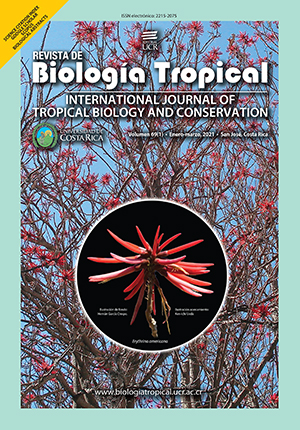Abstract
Introduction: Pentaclethra macroloba is a hyperdominant tree in the Amazon estuary of great socioeconomic importance for the region because the oil from its seeds is a powerful herbal medicine. Objective: We aimed to characterize the morphological structure, the morphological adaptations in response to the daily flooding of the Amazon estuary and the biogeographic area of P. macroloba. Methods: Detailed description of the external morphology, from germination to the adult tree, was obtained from individuals located in floodplain forest, Northeast Amazonia. The occupation area and the geographical extension of P. macroloba were determined from point of geographical coordinates of botanical samples deposited in the digital collections of Mobot and SpeciesLink. Results: Adult individuals have adapted structures in response to daily flooding, such as: adventitious roots to increase respiratory efficiency and lenticels in the trunk, serving as a connection point for oxygen transport between the root and the aerial part. Dried fruit favours the activation of the explosive dehiscence mechanism, allowing the seed to be expelled long distance. Deltoid shape of the seed allows water fluctuation and more efficient dispersal. Seedling is phanerocotylar hypogeal and with one pair of reserve cotyledons that provide the seedling an extra source of energy to escape the flood. Germination rate was 78 % and the speed was 0.2 seeds.day-1. Circular buffer method revealed the presence of 123 subpopulations of P. macroloba distributed in a radius of 5 699 943 km² across the Neotropical region. Conclusions: Much of the morphological structures of P. macroloba are adaptive and evolutionary responses to the periodically flooded environment of the Amazon estuary, showing that these environments select the trees, best adapted, to inhabit the flood. P. macroloba has a wide geographical area denotes the plasticity of adapting to different environments, which may justify its monodominance in some regions.
##plugins.facebook.comentarios##

This work is licensed under a Creative Commons Attribution 4.0 International License.
Copyright (c) 2021 Adelson Rocha Dantas, Marcelino Carneiro Guedes, Caroline da Cruz da Cruz Vasconcelos, Jaynna Gonar Lobo Isacksson, Dayane Nathália Barbosa Pastana, Ana Cláudia Lira-Guedes, Maria Teresa Fernandez Piedade







